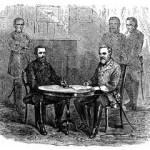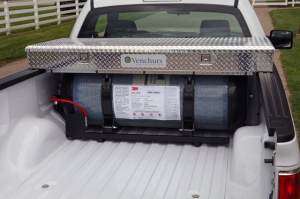
Robert Menard
Certified Purchasing Professional,
Certified Professional Purchasing Consultant, Certified Green Purchasing Professional, Certified Professional Purchasing Manager
Editor’s Note: This is the third part of a four part series on the battle that ended the American Civil War and the negotiations between Confederate General Robert E. Lee and Union General Ulysses S. Grant. Click here for Part One and here for Part Two. For a short but instructive video filmed on site describing the days leading up to the surrender, please see this instructive video. These next two post are filled with quotes taken from Grant’s memoir.
During their meeting to discuss the terms of surrender, as Grant wrote in his memoir, “I said I meant merely that his army should lay down their arms, not to take them up again during the continuance of the war unless duly and properly exchanged. He said that he had so understood my letter. The two generals shared some small talk, during which time Lee informed Grant that he remembered the junior soldier well from years before, an observation that Grant doubted, although he did not verbalize his suspicion at the time. This is another gesture of respect for his honorable opponent.
You may recall hearing in history class that the initials “U S” for Grant stood for “Unconditional Surrender”. That is an unfortunate myth not deserved by the compassionate and heroic measures extended to his fellow general and countrymen at the time. Curiously, Lee considered the Confederacy to be a separate country and Grant did not. Nevertheless, Grant was wise enough to know that depriving Lee, and the confederate citizens, of dignity might well foment a future rebellion.
Negotiation Lesson Four Never drive your counterpart beyond a reasonable position
General Lee suggested that the terms proposed by Grant ought to be written out. Here is some of that text written by Grant. “…I propose to receive the surrender of the Army of N. Va. on the following terms, to wit: Rolls of all the officers and men to be made in duplicate. One copy to be given to an officer designated by me, the other to be retained by such officer or officers as you may designate. The officers to give their individual paroles not to take up arms against the Government of the United States until properly exchanged, and each company or regimental commander sign a like parole for the men of their commands.”
More importantly, Grant added, “The arms, artillery and public property to be parked and stacked, and turned over to the officer appointed by me to receive them. This will not embrace the side-arms of the officers, nor their private horses or baggage. This done, each officer and man will be allowed to return to their homes, not to be disturbed by United States authority so long as they observe their paroles and the laws in force where they may reside.”
The actors at Appomattox that late August day added texture to the presentation by stressing that a condition of the surrender, insisted upon by Grant, was that no Union soldier would abuse, taunt, or otherwise demean any confederate soldier. Consider how humane and singular this condition was. It may well have saved another war caused by lingering resentment of the vanquished brewing below the surface of imposed servitude, frequently the case in history. The Confederate soldiers were allowed to carry their government issued arms and pile them in rows along the roadway with the dignity of erstwhile warriors intent on resuming their pre –war roles as farmers and ranchers.
By this concession, Grant drove the negotiation to what we could call today the “Win-Win” strategy. The Confederate soldiers were fellow countrymen, heroes and honorable men who fought for their beliefs but lost. Now was the time for healing.
So what does that mean for commercial buyer and seller negotiators? Grant’s message is a simple as it is elegant and timeless. Never drive the buyer or seller to untenable positions. If so, you risk certain retaliation at the first opportunity.

online training in purchasing, negotiation, and sales
Negotiation Lesson Five Allow your counterpart, no matter his station, to thrive
Grant continued in his memoir to relay the exchanges between him and Lee about “…the [Confederate] officers’… private horses and effects, which were important to them, but of no value to us; also that it would be an unnecessary humiliation to call upon them to deliver their side arms.”
Now consider these written words from Grant, “No conversation, not one word, passed between General Lee and myself, either about private property, side arms, or kindred subjects. He appeared to have no objections to the terms first proposed; or if he had a point to make against them he wished to wait until they were in writing to make it. When he read over that part of the terms about side arms, horses and private property of the officers, he remarked, with some feeling, I thought, that this would have a happy effect upon his army.”
“Then…General Lee remarked to me that in their army the cavalrymen and artillerists owned their own horses; and he asked if he was to understand that the men who so owned their horses were to be permitted to retain them. I told him that as the terms were written they would not; that only the officers were permitted to take their private property. He then, after reading over the terms a second time, remarked that that was clear.”
This is an astonishing tour de force in this negotiation. Grant was willing, indeed in high favor of allowing many Confederate soldiers (not just officers) to keep their horses that they would need for basic transportation and agricultural services. Lest wise, they might starve and rejoin an insurrection. These are Grant’s words.

Click here for Bob’s book and CDs
“I then said to him [Lee] that I thought… that most of the men in the ranks were small farmers. The whole country had been so raided by the two armies that it was doubtful whether they would be able to put in a crop to carry themselves and their families through the next winter without the aid of the horses they were then riding. The United States did not want them and I would, therefore, instruct the officers I left behind to receive the paroles of his troops to let every man of the Confederate army who claimed to own a horse or mule take the animal to his home. Lee remarked again that this would have a happy effect.” All romance aside, as Grant noted, there was not talk of Lee surrendering his sword or side arms to Grant, in ceremonial submission.
Grant clearly harbored no intent of revenge or harvest of the spoils of war. On the contrary, Grant sought to reunite a severely damaged national psyche and character by drawing upon the well of American goodness. Lee was his willing companion, and all of us, the beneficiary of their wisdom, should be eternally grateful.
In a magnanimous gesture of good will and brotherhood, Grant acceded to Lee’s request for “rations and forage” for his men. Grant asked how many men to which Lee replied “about twenty-five thousand”. Grant authorized Lee to “send his own commissary and quartermaster to Appomattox Station, two or three miles away, where he could have, out of the trains we had stopped, all the provisions wanted. As for forage, we had ourselves depended almost entirely upon the country for that.”
How honorable that the Confederate soldiers were allowed merely to speak their renouncement of the war (paroling) as a condition of going free with his animals and arms.

 Toyota’s price reduction aligns with price drops across the board for plug-in vehicles, whether sold or leased. The Nissan Leaf, Fiat 500e and the Chevy Spark can be leased for $199 a month. In June, Honda dropped the Fit EV from $389 to $259 a month. In July, Ford slashed the Focus EV by $4,000. In August, GM cut $5,000 off the sticker price of the Chevy Volt.
Toyota’s price reduction aligns with price drops across the board for plug-in vehicles, whether sold or leased. The Nissan Leaf, Fiat 500e and the Chevy Spark can be leased for $199 a month. In June, Honda dropped the Fit EV from $389 to $259 a month. In July, Ford slashed the Focus EV by $4,000. In August, GM cut $5,000 off the sticker price of the Chevy Volt.








